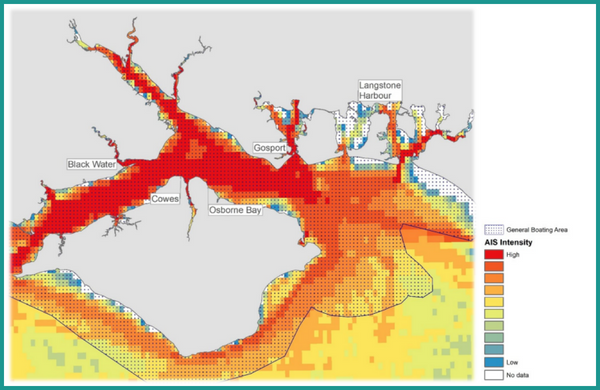Recreation - Motorised Craft

This activity includes the use of motorised vessels, including motorboats (powerboats) and yachts in marine waters. This category also includes watersports that are towed behind a motorised vessel including wakeboarding, waterskiing and parascending. In general, these activities take place in coastal, inshore and offshore waters all around the coastline where marina and berthing facilities, or launch facilities (slipways), are available. Although these activities are widespread, activity in England is mostly concentrated around the southeast and south coast, where there is a high concentration of marinas and clubs.
Department of Transport data shows that there are approximately 14-16,000 available PWCs in the UK with about 1,200 new craft arriving each year. Their life expectancy is about 8 to 10 years. Over ninety per cent of new PWCs are sit-on craft with the remaining mainly used for organised racing. The average age of an owner is 35 and the majority of craft are 2/3 seater.
Activity Map
The map on this page shows recreational boating intensity within the Solent Maritime SAC with data reproduced under licence from the Royal Yachting Association. The mapping was carried out by Natural England as part of their Seagrass Natural Capital Assessment for the Solent Maritime SAC (2021).
Impacts
Natural England’s publication ‘Motorised watercraft (powerboating and sailing with an engine) (EIN027)’ reports that the main impacts from this activity are:
- Abrasion/disturbance of the surface and sub-surface sediment in shallow subtidal habitats through propeller/engine wash.
- Underwater noise disturbance of marine mammals and birds, related to engine operation during the activity.
- Above water noise and visual disturbance, of hauled out seals and birds related to people and/or vehicle noise during vessel launch/recovery from slipways and from people noise, engine operation and the vessel moving through waves (craft striking waves or ‘hull slap’) during the activity.
- Visual disturbance of marine mammals and birds, related to the presence of people and the vessel during launch/recovery and during the activity.
Operation Wavebreaker
With more people holidaying at home, Hampshire Constabulary's Marine Support Unit are urging people to be considerate when using our waterways. In 2020, the team launched Operation Wavebreaker to tackle dangerous use of vessels and other anti-social behaviour in the Solent and other waterways across Hampshire and the Isle of Wight. The operation sees its Marine Support Unit working closely with partner agencies, including the RNLI and Maritime and Coastguard Agency, Harbour Masters, the MOD Police and others throughout the season to address and resolve issues.
Langstone Harbour Jetski Permits
LHB has a long running jet ski permit scheme which requires all participants to abide by harbour bylaws including the 10kt speed limit. From this year, participants will be required to send copies of their insurance certificates to be eligible for a permit. Skiers without formal qualifications will also be told that they will need to enrol in a certified jet ski accreditation course this year, as permits will not be issued without a qualification next season. In addition, anyone wishing to use a kayak, canoe or stand up paddleboard within harbour limits will be required to pay harbour dues.
Department for Transport Management
The DoT is looking to modernise laws and clamp down on dangerous driving of jet skis to protect the public and coastal areas. It proposes to bring recreational and personal watercraft, such as jet-skis and speedboats within the scope of the provisions of the Merchant Shipping Act 1995. Under the current system, local authorities (LAs) have the power to regulate speed and nuisance driving through byelaws, with the power to fine those breaching the rules up to £1,000. Although many LAs have introduced speed limits, signage and ID tags to prevent accidents, there remains a number of unmanaged waters around the UK.
National Watersports Participation Survey
A National Watersports Participation Survey is conducted annually by a consortium of leading marine bodies including British Marine, Royal Yachting Association (RYA), Maritime and Coastguard Agency (MCA), Royal National Lifeboat Institution (RNLI), British Canoeing (BC) and the Centre for Environment, Fisheries and Aquaculture Science (Cefas). For 2021, the key findings included:
- Coastal activities, which generally require little or no specialist training or equipment, are done the most frequently. The trend in 2021 is that more infrequent participants have taken part.
- Powered sports are most likely to have participants doing the activity once in the past 12 months. Again, the trend is moving to more casual participation.
- There has been a trend towards an experience culture, especially among younger age groups.
- There has been an increase in participation across sailing, powered and manual activities, while coastal activity remained largely static.
- Boating activities, marinas and watersports centres were very busy as people were largely holidaying in the UK due to severe restrictions on international travel.
Resources
- Solent Speed Limits Map - Hants Marine Police Unit
- RYA, RNLI and Personal Watercraft Partnership (PWP) videos
- Jetskis and Birds - RSPB Guidance
- RYA guidance on wash and noise
- Sussex IFCA -'Recreational Sea Angling (RSA) Information on Marine Protected Areas (MPAs)'.
- The Green Blue Guides - best environmental boating practice
- Link to You Tube videos on RYA channel
- Green Blue online educational activity worksheets
- Natural England IPENS Public Access and Disturbance Theme Plan
- Thames Estuary Code of Conduct for Personal Water Craft Users
- WiSe Scheme - The UK's national training scheme for minimising disturbance to marine wildlife
- Personal Watercraft Partnership


